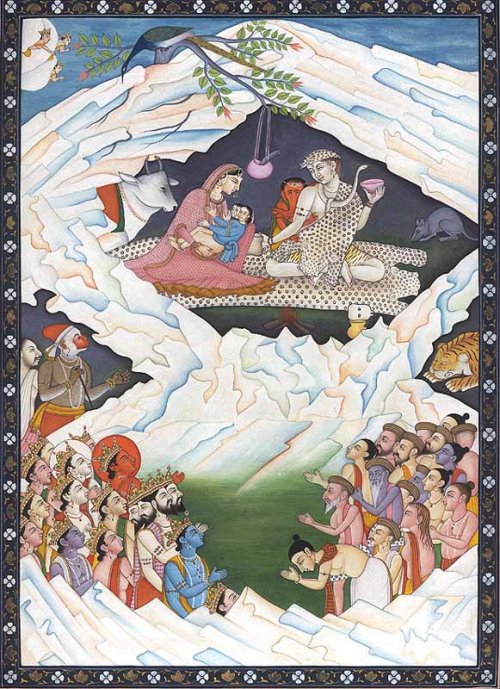18th-century illustration of Mount Kailash, depicting the holy family: Shiva and Parvati, cradling Skanda with Ganesha by Shiva’s side
A culture often creates centers, While someone may gets powerful, and everything gets built around them and the rest is history, the concept of sacred center came from the nature of the Earth itself. In Egypt the meridian was both explicit and dominant in the south to north flow of the Nile, after the desertification of the Sahara. In Britain and elsewhere however, large landscape geometries were created of an approximately circular nature and this is a natural result of the near-spherical Earth.
The Lord of the World is a very ancient concept, often referred to as a Axis and therefore congruent with the pole of the Earth. Yet, even Superman does not live actually at the pole – that is not the point. The point is that in a cosmos with the Sun at the centre of the planetary system and with the Earth spinning about its poles, the central organising power is seen at the centre and in the case of a civilisation, that centre causes manifestations out into a sacred pattern, having numeric and geometric properties. For example a polygon such as a square manifests the “holy city of Jerusalem”, twelve sides the autocracy of the ZodiacThe 12 constellations through which the sun passes in the solar year of 365.2422 days, ten sides the rule of law, and multiple projections out from a centre give alternative views of the same whole – the people in the landscape.
Sacred civilisations have been characterised as being an enchantment of the landscape by John MichellWriter, sacred geometer, metrologist and mystic: his books were highly influential in defining the form of the British earth mysteries movement., and in this we can reject our fears of magic to see that all civilisations enchant their populations, but that a sacred foundation will aim to provide an organising idea that is harmonious with the creation itself according to its highest principles of the purpose and potentials of life. The numerical view of creation explains why regular polygons and similar structures are employed: they uniquely achieve harmony and, from our perspective, this uniqueness of approach allows us to see into their numerical knowledge and avoid projecting our own culture “into their shoes” as archaeology often does to make the subject more interesting.
The movement of the Pole to a given latitude results is a situation that would be conceptually obvious to polar explorers – if you set off from the pole in any direction, called an Azimuththe standard angular measurement of angles on the horizon, measured clockwise from zero degrees true North. or Bearing, you are travelling down a north-south meridian. The poles are often mapped with a type of cartography called Azimuthal because unlike most maps, these maps allow your bearing from the centre to be a straight line on the map.
When moving to a latitude other than the pole, the same applies, and the mapping would be called Azimuthal Oblique. In reality, we can set off from anywhere in a straight line and within a degree of latitude the difference of a flat and a spherical Earth will hardly matter. Having measured such a degree as a length, the geographical foot can be determined – meaning that if the degree is longer than another by a fraction, the foot used for your sacred measures in a new centre can be that much longer. This means the same number will, by this technique, divide into a longer degree.
This system of geographical feet was well established in ancient times and recent work has shown a systematic grid of measures that, most fortunately, have revealed further monumental facts about the Earth.
For now it is sufficient to say that a latitude, given a sacred pole or centre, naturally manifests a symmetrical radiating pattern that is measured out using geographical and other symbolically significant feet. The most direct pattern is a circle since it echoes the three-dimensional circularity of the Earth itself, but in two dimensions.
This text was created in July 2003 and only recently found. Its neighbouring texts will be edited to show how some ideas go back but some change.
Influences from John Michell regarding centres were very important, based upon his books; he once advising me that finding the geographical center was a very interesting activity, illustrated in The Sacred Center.


